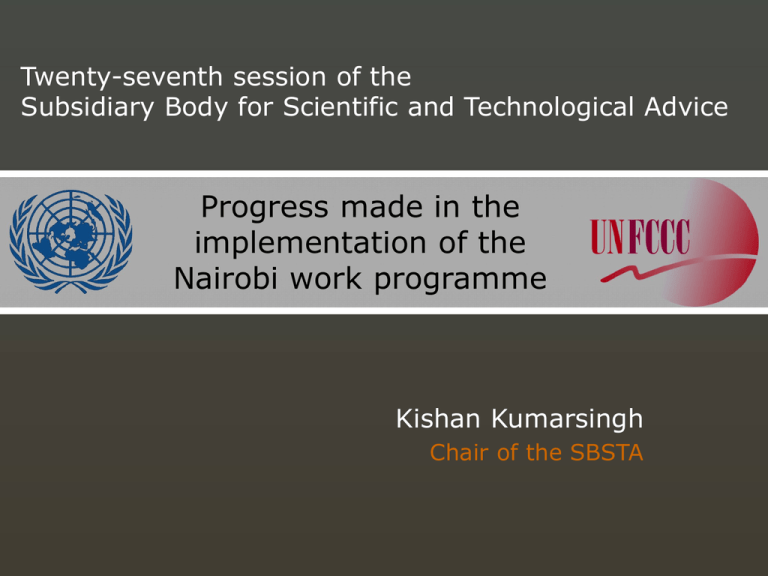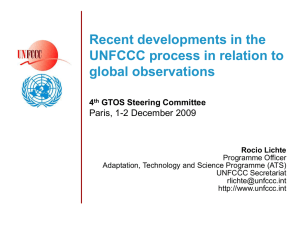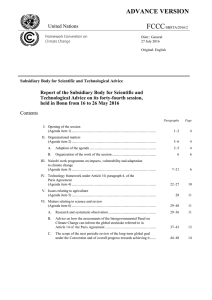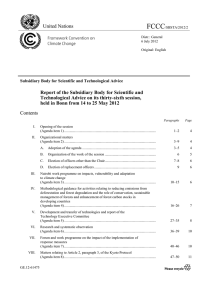Presentation on Progress made in the implementation of the Nairobi work programme under agenda item 7. Fourth Assessment Report of the IPCC
advertisement

Twenty-seventh session of the Subsidiary Body for Scientific and Technological Advice Progress made in the implementation of the Nairobi work programme Kishan Kumarsingh Chair of the SBSTA Content • Structure and objectives • Approach to implementation • Activities and deliverables • Involvement of Parties, organizations and experts • Delivering until Bonn, and the way forward • Concluding remarks Structure and objectives Methods & tools Economic diversification Data & observations Assist all Parties, in particular developing countries, including LDCs and SIDS, to Technologies for adaptation Modelling, scenarios & downscaling Improve their understanding of climate change impacts and vulnerability Risks & extreme events Increase their ability to make informed decisions on how to adapt successfully Adaptation planning & practices Research Socio-economic information Approach to implementation 1. Mandated SBSTA activities 2. Furthering the reach of the mandated activities 3. Catalysing action by Parties and organizations Approach to implementation 1. Mandated SBSTA activities – Submissions from Parties and relevant organizations – Synthesis reports and web-based interface on adaptation – Workshops and expert meetings, and subsequent reports ‘From Nairobi to Bali’ 1.Mandated activities Submissions on: • Methods and tools • Adaptation planning and practices Submissions on: • Risks and extreme events February May 18-20, Cairo, Egypt: Workshop on risks and extreme events June ‘From Nairobi to Bali’ 1.Mandated activities Synthesis of information on: • Adaptation planning and practices • Outputs from expert groups August Cairo workshop report 10-12, Rome, Italy: Workshop on adaptation planning and practices Synthesis of information on: • Methods and tools • Research • Technologies for adaptation • Economic diversification September Submissions on: •Economic diversification •Data and observation • Climate modelling, scenarios and downscaling • Socio-economic information • Group of experts Rome workshop report Approach to implementation 2.Furthering the reach of mandated activities Generating expanded ownership and ensuring expert input: • Small preparatory meetings with experts from different organisations • Expert consultancy • Invitation experts in addition to Party nominees Dissemination and outreach: – Two issues of reader-friendly versions of Nairobi work programme – Dissemination of products through NWP partner organizations – Groundwork for NWP web portal Approach to implementation 3.Catalyzing action by Parties and organizations – Engaging a wide range of organizations in the different activities, and encouraging them to undertake their own activities towards the Nairobi work programme objectives – Introducing Call for Action sheets and encouraging Action Pledges – Enhancing cooperation among multiple partners Engaging organizations and stakeholders Views of Parties on gaps and needs ‘Demand’ for adaptation activities Workshops and expert meetings with recommendations Calls for Action Action Pledges ‘Supply’ of adaptation activities 90 organizations active in the NWP with focal points Parties, organizations, experts, civil society, private sector active in adaptation Involvement of Parties, organizations and experts Attendance at the workshops in 29% from Annex I Parties Cairo and Rome 100 representatives from Parties and relevant national experts 71% from Non-Annex I Parties 17% from NGOs 96 representatives from a broad range of organizations as well as the three expert groups under the UNFCCC (LEG, CGE and EGTT) 44% from UN organizations and other IGOs 39% from regional and national development/ research institutions Delivering on the initial activities ‘From Bali to Bonn’ Expert meeting on socioeconomic information February Reports on the expert meetings on socioeconomic information; methods, tools, data and observation; and the informal meeting Joint expert meeting on methods and tools Submissions on and data and further activities observation by 21 March March Informal meeting of representatives from Parties to consider the outcomes of NWP activities April Review of the work programme, and further activities May June SBSTA 28 Web-based interface providing information on existing adaptation practices and local coping strategies In-session workshop on climate modelling, scenarios and downscaling December SBSTA 29 Summary report consolidating the results of the implementation of the NWP by SBSTA 29 Expected way forward UNFCCC SBSTA Completed activities prior to SBSTA 28 Informal meeting and consideration at SBSTA 28 Possible input to related adaptation activities under the UNFCCC SBI Enhanced assistance to all Parties, in particular developing countries, including LDCs and SIDS New activities after SBSTA 28 Findings of IPCC AR4 Wide range of organizations undertaking their own activities Enhanced capacity of all Parties to undertake practical adaptation action Concluding remarks • Activities, deliverables and work of involved organizations constitute a solid foundation for contributing to the main objective of the Nairobi work programme • The Nairobi work programme could provide a valuable contribution to the package of adaptation activities in the future regime Thank you All official documents are available at the documents counter More information available in the brochure and on the UNFCCC website http://unfccc.int/3633.php






